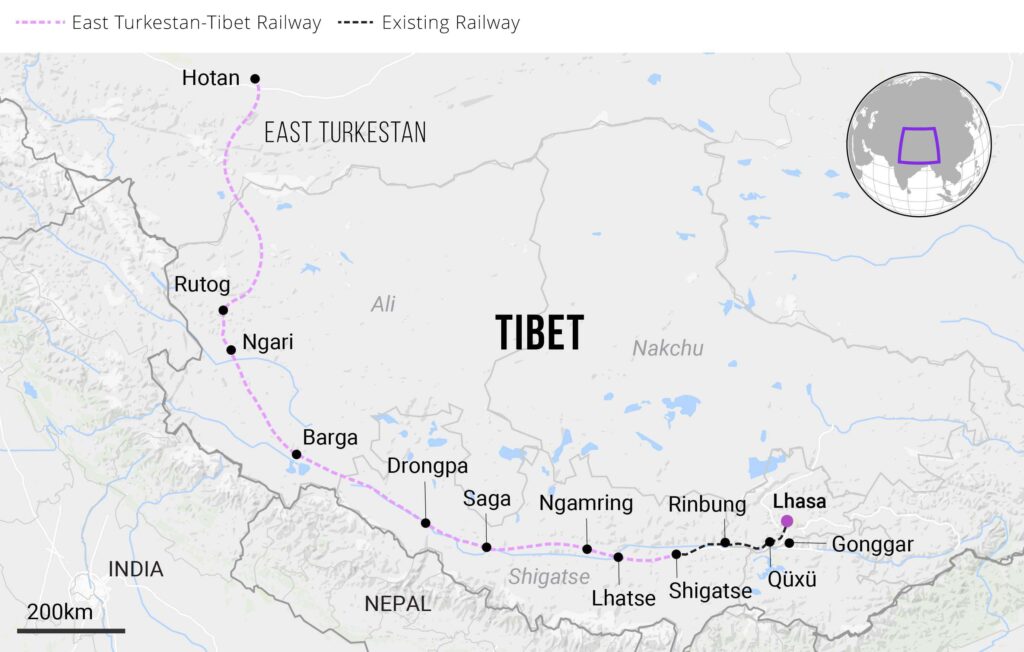(TibetanReview.net, Aug16’25) – The Xinjiang -Tibet Railway which China plans to begin building later this year will be the most expensive as well as technically the most difficult to build in the world by far, reported ejinsight.com Aug 15, citing Chinese sources. The objective is strategic, and less of commercial value, the report noted.
The new railway line will run between Hotan in East Turkestan (Xinjiang province) and Shigatse in Tibet over a distance of 2,000 kilometres. It will cost 400 billion yuan, or 200 million per kilometre, to build. The price tag makes it more than double that of the most expensive line currently under construction – a high-speed railway of 679 kilometres from Moscow to St Petersburg that is costing US$25.3 billion, the report noted.
The Xinjiang -Tibet Railway will pass through mountains, glaciers, frozen rivers and permafrost, with 62% consisting of bridges and tunnels, the report noted.
Construction will begin in November this year and will take 10 years to complete. Trains will travel at 120-160 kilometres an hour between these two remote regions of the People’s Republic of China where campaigns for autonomy or restoration of independence continue to haunt Beijing.
For building the railway, the state-owned National Railway Group launched the Xinjiang-Tibet Railway Company on Aug 7 with a registered capital of 95 billion yuan. But this is only a fraction of the actual cost of building the railway.
* * *
The new railway line will never earn a commercial return on this Pharaonic investment. But Beijing has bigger objectives, the report noted.
“Many places in the western regions are undeveloped and the major strategic channels to enter and leave Tibet and Xinjiang need to be strengthened,” Liu Wenxian, a senior official of the planning department of the China Railway Group, has said.

“The priority is to strengthen the construction of strategic links and effectively guarantee the implementation of major national strategies,” he has said.
This means defence against India and possible uprisings by Uyghurs or Tibetans, the encouragement of Han settlement and quicker development of the mineral and other resources and economies of the two regions, the report noted.
The line will run through Aksai Chin, a region occupied by China since 1950 but claimed by India, and close to the Line of Actual Control (LAC), which marks the disputed border between India and China-occupied Tibet. The line will dramatically improve Beijing’s ability to bring troops and equipment to the LAC.
* * *
The report said the second objective is to encourage Han settlement in Tibet, as in Xinjiang. In the 1953 census, Xinjiang’s population was 4.87 million, of whom 75% were Uyghur and 6% Han. In 2020, the population reached 25.85 million – 45% Uyghur and 42% Han, with Hans having become the majority in the northern, and more developed, half of Xinjiang.
In the case of Tibet Autonomous Region (TAR), the 2020 census showed its population to be 3.65 million, with Tibetans accounting for about 90%, and Han and other minorities 10 %.
Han people do not want to live in TAR because of its remoteness, high altitude, severe climate, unfamiliar cuisine and lack of economic opportunities. However, the new railway line will make it more attractive to Hans by establishing towns and factories linked to the 35 stations on the line, the report noted.
The report saw China’s railway plans for Tibet to be comparable to the Pacific Railroad in the US built in the 1860s. It enabled tens of thousands of white settlers to move to western states for farming, mining and jobs in towns and cities. It enabled factories on the Pacific Ocean to transport their goods easily to the Eastern Seaboard, for export to Europe.
China opened the TAR to its railway network for the first time with the opening of the Qinghai-Tibet’s Xining-Lhasa route in 2006. With over 960 kilometres above 4,000 metres above sea level, it is the highest railway in the world.
The Xinjiang–Tibet Railway will form part of China’s five planned railway corridors into Xizang — alongside the completed Qinghai–Xizang Railway, the under-construction Sichuan–Xizang Railway and planned Gansu–Xizang and Yunnan–Xizang railways, China’s official chinadaily.com.cn earlier said Aug 10, using the Sinicized name for Tibet. The Sichuan line is due to open in 2032.


